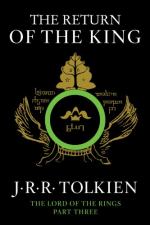|
|
Return of the King Author/Context
John Ronald Reuel Tolkien was born in South Africa on January 3rd 1892. With the next few years his family moved back to England and his father died in South Africa. Eight years later his mother died and he and his brother became the charges of a Catholic priest. He won an academic scholarship and earned a degree in Classics before he enlisted in World War I. He married his childhood sweetheart and lost many friends in the war. He eventually became a professor of Philology and English, focusing on the language and literature of Northern Europe in the early Middle Ages. During his tenure at Oxford University, he belonged to a group called the inklings, which also included the author C.S. Lewis. His first fantasy novel, The Hobbit, was published in 1937 and his trilogy, The Lord of the Rings wasn't published for another twenty years. Tolkien had three sons with his wife Edith who died in 1971. Two years later, Tolkien died in Oxford.
Tolkien still maintains a shaky place in literature. Fantasy had little readership in the first half of the twentieth century. While he also published occasionally as a scholar (his edition of Sir Gawain and the Green Knight is still in use), he was not as active or prolific as his colleague C. S. Lewis. Both were deeply religious men who created their visions of other fantastic worlds.
Tolkien's first book, The Hobbit, was published in 1937. It was originally dismissed as juvenile by many of his friends. It had evolved from stories he told his children into a full-length tale he shared with his discussion group. Former Oxford students, however, encouraged the professor to complete his work with his own illustrations. As shown years later, Tolkien felt a certain kinship with his characters: "I am in fact a Hobbit (in all but size). I like gardens, trees and unmechanized farmlands; I smoke a pipe, and like good plain food (unrefrigerated)...." The Hobbit was a financial success, although many critics panned it.
Almost twenty years after the publishing of The Hobbit, Tolkien's The Lord of the Rings was published in the form of a hardback trilogy. It was well received but not as financially successful as the initial sales of The Hobbit. Ten years later, however, an unauthorized edition was printed in paperback in the U.S. Within six months, Tolkien issued an authorized edition. Tolkien mania had hit the States. Tolkien fan clubs sprouted up all over. His books had become a phenomenon. Before Tolkien died, his son promised that he would finish editing Tolkien's longest labored-over work The Silmarillion. In 1977, this collection of histories and legends became an international best seller.
The Lord of the Rings represented something completely different from The Hobbit. It was not exactly children's literature, but no critic deemed it exclusively for the adult. After World War II, many readers found significant parallels in its stories. The Lord of the Dark, Sauron, could be seen as an allusion to the dictators of the War. The ultimate power of the Ring represented atomic weapons to some. The Return of the King continues the story begun in The Two Towers and The Fellowship of the Ring. It chronicles the separate experiences of the Company of the Ring as two of them push on towards the Ring's final destruction and the others prepare the world to withstand the terrible attacks of the Dark Lord Sauron. This is the book of battles and destruction. When the Ring has finally been destroyed, the men of the earth must look to rebuilding their world. It is truly the tale of the passing of one age and the beginning of another.
The effects of the Tolkien phenomenon are still felt in the modern era. The fantasy genre has grown exponentially since the publishing of The Hobbit, an occurrence that may have been all but impossible without Tolkien's work. While Tolkien's standing in the ranks of literature continues to be debated, his books continue to sell every year. As William Dowie said "Other writers achieve popularity and admiration as well as critical acclaim; but the Tolkien books breed a kind of fierce discipleship that seeks to proselytize the unenlightened."
Bibliography
Dowie, William. The Gospel of Middle-Earth according to J.R.R. Tolkien. from J.R.R. Tolkien, Scholar and Storyteller. Salu and Farrell, eds. London: Cornell University Press, 1979.
Pearce, Joseph, ed. Tolkien: A Celebration. Great Britain: HarperCollins, 1999.
Rogers, Deborah and Ivor. J.R.R. Tolkien. Boston: Twayne Publishers, 1980.
Tolkien, J.R.R. The Hobbit. New York: Ballantine Books, 1937.
Tolkien, J.R.R. The Fellowship of the Ring. New York: Ballantine Books, 1955.
Tolkien, J.R.R. The Return of the King. New York: Ballantine Books, 1955.
Tolkien, J.R.R. The Two Towers. New York: Ballantine Books, 1955.




